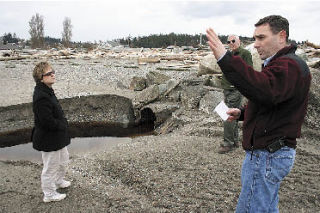A troublesome and deteriorating 42-inch outfall located near the west end of Oak Harbor’s Windjammer Park is ready to go under the microscope.
After 40 years, the pipe has become a mere shadow of its former self. Consequently, the Oak Harbor City Council approved a $280,000 contract for engineering design services that will entail exhaustive study of the pipe.
Approximately 100 feet of the outfall has been washed away by tidal action or physically removed as it has failed.
The corroding outfall drains a large area of the city and routinely becomes blocked by shifted sand. The storm drain was able to accommodate the outfall in the past. That is no longer the case.
Combined with a tidegate in dire need of attention, the project will help to address flooding issues.
“The pipe has served us well for 40 years, but the new materials are superior and should last even longer,” said City Project Engineer Arnie Peterschmidt Monday.
Clogging has resulted in a string of problems, not the least of which are flooding upstream of the outfall and subsequent maintenance problems requiring staff to undo preventable problems.
The council approved the first two phases of the three-phased reconstruction project. The city will contract design services with Moffat & Nichol, Inc.
Phase one will entail carrying out a battery of technical surveys, as well as the generation of cost estimates for the new facilities and a preferred outfall alternative. However, the significant amount of effort will be directed at securing the necessary environmental permits associated with working in a sensitive shoreline area. City Engineer Eric Johnston told the board at last week’s meeting the permitting process could take a while, with nine months being the earliest, realistic estimate for approval.
The second phase will yield detailed construction plans and construction contract documents based on the first phase’s work. Johnston estimated that both phases will take approximately 14 to 26 months.
Phase three, the actual construction, is the wild card. With an estimated cost of $1 million, the engineer told the council that funding sources have yet to be identified.
City Administrator Paul Schmidt said the city will tackle the funding quandry while the first two phases are underway.
Johnston also said different design options are being discussed, one of which is extending the pipe 2,000 feet out. Burying the outfall pipe is also a possibility. He said whatever option they choose, the
pipe should be virtually invisible.
“We’d like to make sure this project doesn’t turn into an engi-
neering marvel,” Johnston said.
“I don’t know what the answer
will be yet. I don’t think going out into the harbor is the way.”



